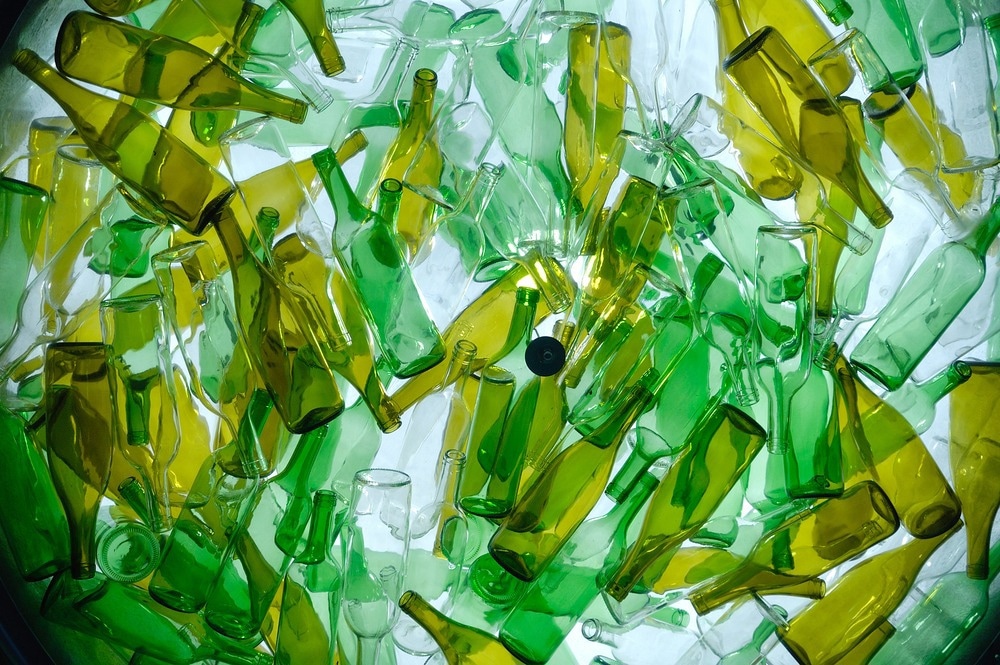 By JanakyReviewed by Lexie CornerUpdated on Aug 1 2024
By JanakyReviewed by Lexie CornerUpdated on Aug 1 2024Glass is a non-crystalline, brittle material made from limestone, sand, and baking soda. It is one of the oldest synthetic materials, dating back to ancient Egypt around 3000 BC.1

Image Credit: Josep Curto/Shutterstock.com
While it was originally used for jars, beads, and bowls, glass now serves numerous purposes, such as windows, shelves, lighting, appliances, fiber optic cables, and solar panels. The limited lifespan of these products has prompted researchers to find more effective ways to recycle them.
Characteristics of Glass
In addition to its hardness and optical transparency, glass possesses qualities that are indispensable across various industries and everyday products. Its exceptional resistance to chemicals and weather ensures durability in diverse environments.2 Moreover, glass can be molded into intricate designs, including heat-resistant glassware that maintains structural integrity under high temperatures.
Glass is also valued for its hygienic properties due to its inert composition, free from toxic substances, which makes it ideal for packaging food and pharmaceuticals.3 Its smooth, non-porous surface prevents bacterial growth and eliminates odor absorption, further enhancing its suitability for sensitive applications.
Different glass applications necessitate varying chemical compositions. The most common type is container glass, but there are many other varieties, including flat glass, tempered safety glass, silicate and borosilicate glass, float glass, mirrors, patterned glass, filament glass fiber, and sheet glass.1
Manufacturing of Glass
Glass-making involves four main steps: preparation of raw materials, melting in a furnace, forming/shaping, and finishing.
- Preparation of Raw Materials: Soda-lime-silicate glass typically uses silica sand, soda ash, and calcium carbonate, while borosilicate glass uses boron trioxide from borax and alumina from feldspar or bauxite.4 These materials are crushed and stored in bins. They are then mixed with cullet (recycled glass) using a gravity feed system and weighed before being sent to the melting furnace.
- Melting: In the furnace, the mixture melts and moves through the melter to the refiner, where it is heat-conditioned for forming.
- Forming/Shaping: The molten glass is shaped using various techniques like pressing, blowing, drawing, floating, or rolling. These methods create different glass products, from containers to flat glass and fibers. Techniques include automated blowing in molds, floating molten glass over tin to produce flat glass, and forming fibers through rotary wool forming or mechanical drawing.1
- Finishing: The glass undergoes coating and annealing, a process of slowly cooling to remove internal stresses and increase durability.
Environmental Impact of Glass Disposal
The glass manufacturing process pollutes the environment through emissions of carbon dioxide (CO2), sulfur dioxide (SO2), nitrogen oxides (NOx), and dust.5
CO2 from natural gas combustion and raw material decomposition contributes to global warming. SO2 from sulfate decomposition and NOx from high melting temperatures cause acidification and smog formation.5
Dust released during mixing, storage, handling, and transportation makes the environmental impact of the process worse.
To mitigate these effects, dust emissions can be reduced using closed conveyors, efficient loading and unloading processes, enclosed silos, and separate batch preparation and storage areas.6
Humidifying fine particles with alkali solutions or water and implementing proper control operations in the furnace feed area also help. Reducing sodium in batch materials and using low-sulfur fuels effectively control sulfur oxide emissions.
Recycling Process of Glass
Glass is easily recycled because it can be remelted and reformed into new products with the same qualities as the original, a process known as closed-loop recycling.1 While reusing glass containers was common in the 19th and 20th centuries, large-scale recycling efforts began in the 1970s.
Recycling starts with collecting broken or used glass and taking it to a treatment plant. The glass is sorted by color, and impurities like metals and plastics are removed.7 The clean glass is then crushed into small pieces called cullet, melted at high temperatures, and molded into new products like bottles and jars.
Recycling glass offers significant environmental benefits, including saving around 42 kWh of electricity, 20 gallons of oil, 1.5 cubic meters of landfill space, and preventing the release of 3.5 pounds of air pollutants per ton of recycled glass.8
The benefits of recycling are recognized by manufacturers and governments, encouraging the reuse of glass containers. Various sorting techniques, such as hand sorting, sieving, magnetic sorting, and vacuum sorting, ensure the recycling process is efficient and clean.1
Applications of Recycled Glass
Recycled glass is a valuable material across various industries. It is commonly used to create landscaping materials, decorative tiles, and new glass containers, leveraging its aesthetic and functional properties in construction and design.
In the construction industry, cullet can be used as an aggregate in concrete. It has been found that replacing up to 20 % of fine aggregate with cullet can yield optimal performance and durability results. Additionally, cullet can serve as a flux agent in the manufacturing of bricks, enhancing the production process.9
Recycled glass is also used to produce ceramic sanitary ware, offering a sustainable alternative to traditional raw materials. In the fiberglass industry, cullet is utilized due to its high tolerance levels, with some manufacturers incorporating up to 80 % recycled glass in their products.10
Moreover, low-quality cullet is used to manufacture ballotini—driving safety reflective beads—for road markings and signs. It is also used in roadbed aggregate and fiberglass insulation, contributing to improved safety and efficiency in construction and infrastructure projects.11
These spheres, made from flint cullet, must be colorless and highly reflective, making them ideal for enhancing visibility and safety in various settings.
Recent Innovations in Glass Recycling
Advancements in glass recycling technology have significantly improved its sustainability and efficiency. One notable innovation is the development of porous glass, which has exceptional adsorption capacity and flexibility, making it useful for environmental applications like contaminant removal from water and wastewater.12
Several industries are finding new applications for recycled glass. In the construction industry, a sustainable solution is the development of all-glass, load-bearing structures using interlocking cast units.13
This system eliminates the need for adhesives by employing dry connections, which not only facilitates recycling by avoiding adhesive contamination but also optimizes the building process by removing the need for precise adhesive application. The interlocking geometry of the units provides stability against lateral movement.
Efforts are also being made to reduce the environmental impact of glass production and recycling processes. Modern glass furnaces are now designed to minimize emissions of harmful substances like SO2 and nitrogen oxides, which contribute to environmental acidification.6
Overall, these advancements highlight the significant progress in glass recycling technology, which aims to minimize the environmental impact of glass production and disposal.
Discover More: What are the Electrical Properties of Glass?
References and Further Reading
- Dyer, TD. (2014). Glass recycling. In Handbook of recycling. DOI: 10.1016/B978-0-12-396459-5.00014-3
- Justino de Lima, C., Aldinger, B., de Haan, P., Bristogianni, T., & Veer, F. (2022). Effects of composition on the durability and weathering of flat glass. Glass Structures & Engineering, 7(2), pp.139-155.
- Williamson, B. (n.d). Benefits of Glass Jars for Pharmaceuticals. [Online] Origin Pharma Packaging. Available at: https://www.originltd.com/useful-resources/glass-packaging/benefits-of-glass-jars-for-pharma/
- LJ Star. (n.d). Borosilicate vs. Soda Lime Glass: A Detailed Comparison. [Online] LJ Star. Available at: https://www.ljstar.com/resources/glass-comparison/
- ACG Glass Europe. (n.d.) Environmental Impact of Flat Glass Production. [Online]. AGC. Available at: https://www.agc-glass.eu/en/sustainability/decarbonisation/environmental-impact
- World Bank Group. (2007). International Finance Corporation, Environmental, Health, and Safety Guidelines for Glass Manufacturing. [Online] World Bank Group. Available at: https://documents.worldbank.org/en/publication/documents-reports/documentdetail/890101490072833164/environmental-health-and-safety-guidelines-for-glass-manufacturing
- Yao, Z., Qin, B., Huang, Z., Ruan, J., Xu, Z. (2021). Green combined resource recycling system for the recycling of waste glass. ACS Sustainable Chemistry & Engineering. DOI: 10.1021/acssuschemeng.1c01797
- Strategic Materials Inc. (n.d). Environmental Benefits. [Online] Strategic Materials Inc. Available at: https://www.smi.com/glass-recycling-environment
- Silva, RV., De Brito, J., Lye, CQ., Dhir, RK. (2017). The role of glass waste in the production of ceramic-based products and other applications: A review. Journal of Cleaner Production. DOI: 10.1016/j.jobe.2019.100965
- Majdinasab, A., & Yuan, Q. (2019). Post-consumer cullet and potential engineering applications in North America. Resources, Conservation and Recycling. DOI: 10.1016/j.resconrec.2019.04.009
- Mohajerani, A., Vajna, J., Cheung, T. H. H., Kurmus, H., Arulrajah, A., & Horpibulsuk, S. (2017). Practical recycling applications of crushed waste glass in construction materials: A review. Construction and Building Materials. DOI: 10.1016/j.conbuildmat.2017.09.005
- X
- Yost, JR. (2022). Mechanical performance of polyhedral hollow glass units under compression. Engineering Structures. doi.org/10.1016/j.engstruct.2021.113730
Disclaimer: The views expressed here are those of the author expressed in their private capacity and do not necessarily represent the views of AZoM.com Limited T/A AZoNetwork the owner and operator of this website. This disclaimer forms part of the Terms and conditions of use of this website.